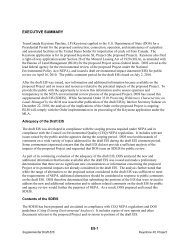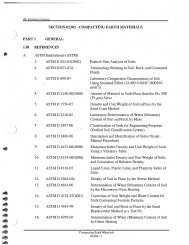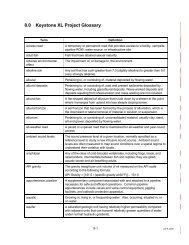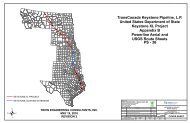2.1 Overview of the Proposed Project - Keystone XL pipeline - US ...
2.1 Overview of the Proposed Project - Keystone XL pipeline - US ...
2.1 Overview of the Proposed Project - Keystone XL pipeline - US ...
Create successful ePaper yourself
Turn your PDF publications into a flip-book with our unique Google optimized e-Paper software.
Draft Supplemental Environmental Impact Statement<strong>Keystone</strong> <strong>XL</strong> <strong>Project</strong>Conditions) would be included in <strong>the</strong> proposed <strong>Project</strong> operations, maintenance, andemergencies manual that would be required by 49 CFR 195.402, and <strong>the</strong>y would also beincorporated into <strong>Keystone</strong>’s existing Operations Control Center (OCC) in Calgary, Canada. Theremainder <strong>of</strong> this section addresses normal operation and routine maintenance and abnormaloperations.<strong>2.1</strong>.11.1 Normal Operations and Routine Maintenance<strong>Keystone</strong> would prepare <strong>the</strong> manuals and written procedures for conducting normal operations,maintenance, inspection, and monitoring activities as required by <strong>the</strong> PHMSA regulations,particularly as required by 49 CFR 195.402 and in <strong>the</strong> applicable PHMSA <strong>Project</strong>-specificspecial conditions (see Appendix B, PHMSA 57 Special Conditions). This would includedevelopment and implementation <strong>of</strong> an annual Pipeline Maintenance Program to ensure <strong>the</strong>integrity <strong>of</strong> <strong>the</strong> <strong>pipeline</strong>. The Pipeline Maintenance Program would include valve maintenance,periodic inline inspections, and CP readings to ensure facilities are reliable and in service. Datacollected in each year <strong>of</strong> <strong>the</strong> program would be incorporated into <strong>the</strong> decision-making process for<strong>the</strong> development <strong>of</strong> <strong>the</strong> following year’s program.The proposed <strong>Project</strong> OCC would be manned by experienced and highly trained personnel24 hours per day, every day <strong>of</strong> <strong>the</strong> year in Calgary. In addition, a fully redundant backup OCCwould be constructed, operated, and maintained, also in Canada. Primary and backupcommunications systems would provide real-time information from <strong>the</strong> pump stations to fieldpersonnel. The control center would have highly sophisticated <strong>pipeline</strong> monitoring systemsincluding a leak detection system capable <strong>of</strong> identifying abnormal conditions and initiating visualand audible alarms. Automatic shut-down systems would be initiated if a valve starts to shut andall pumps upstream would turn <strong>of</strong>f automatically. All o<strong>the</strong>r <strong>pipeline</strong> situations would requirehuman response.The proposed <strong>Project</strong> would include a supervisory control and data acquisition (SCADA) systemto constantly monitor <strong>the</strong> <strong>pipeline</strong> system. The SCADA system would be installed and operatedin accordance with <strong>the</strong> requirements <strong>of</strong> 49 CFR 195 and PHMSA <strong>Project</strong>-specific specialconditions 24 through 31 (see Appendix B, PHMSA 57 Special Conditions). SCADA facilitieswould be located in <strong>the</strong> OCC and along <strong>the</strong> <strong>pipeline</strong> system, and all pump stations and deliveryfacilities would have communication s<strong>of</strong>tware that sends data back to <strong>the</strong> OCC. The <strong>pipeline</strong>SCADA system would allow <strong>the</strong> OCC to remotely read IMLV positions, tank levels, anddelivery flow and total volume. The OCC personnel would also be able to start and stop pumpstations and open and close MLVs. SCADA systems are fur<strong>the</strong>r discussed in Sections <strong>2.1</strong>.11.1,Normal Operations and Routine Maintenance, and 4.13, Potential Releases.The <strong>pipeline</strong> ROW would be inspected via aerial and ground surveillance to provide promptidentification <strong>of</strong> possible encroachments or nearby construction activities, ROW erosion,exposed pipe, or any o<strong>the</strong>r conditions that could result in damage to <strong>the</strong> <strong>pipeline</strong>. The aerialsurveillance <strong>of</strong> <strong>the</strong> <strong>pipeline</strong> ROW would be carried out at least 26 times per year at intervals notto exceed 3 weeks as required by 49 CFR 195.412. Landowners would be encouraged to reportany <strong>pipeline</strong> integrity concerns to <strong>Keystone</strong> or to PHMSA. IMLVs and MLVs at pump stationswould also be inspected. As required by 49 CFR 195.420(b), <strong>the</strong>y would be inspected at intervalsnot to exceed 7.5 months, but at least twice each calendar year.<strong>Project</strong> Description <strong>2.1</strong>-65 March 2013











